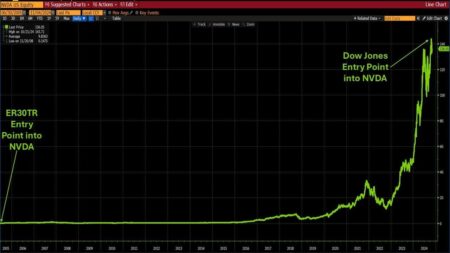The stock market battled several key economic reports last week along with an FOMC meeting to finish the week lower overall. There were additional signs that the economy was weakening that encouraged those hoping for a rate cut sooner rather than later but others were worried that the Fed had waited too long to lower rates.
On one hand, the data on inflation from the CPI and PPI was encouraging but the mid-month reading on Consumer Sentiment fell to a seven-month low. From a technical perspective interest rates do appear to have topped as yields peaked on Monday as they declined for the rest of the week.
The 30-Year T-Bond Yield closed at 4.777% on April 26th but violated its uptrend two weeks ago. The decline last week pushed the yield down to 4.352% which is the lowest close since the start of April. The weekly starc- band is at 4.210% with additional support at 4.066%. The MACDs have both turned negative which does favor a further decline. The 10-year T-Note yield closed at 4.221% with the next support in the 4.038% area.
The S&P 500 edged out the Nasdaq 100 last week by a 1.6% to 1.4% margin. The SPDR Gold Trust was the weakest down 3.5% followed by 2.7% declines in both the Dow Jones Transportation and Dow Jones Utility Average. The Dow Jones Industrial Average lost 2.3% with the iShares Russell 2000 down 1.3%.
The weekly chart of the Spyder Trust (SPY) shows last week’s strong close with the weekly starc+ band at $555.35. This chart illustrates what I see as the recent unhealthy action in the stock market. As SPY has been rising since the middle of May, line a, the S&P 500 Advance/Decline line has been declining. It closed last week slightly below its WMA but is still above the support at line b.
A week of very positive A/D numbers might be enough to turn it higher but it will still be forming lower highs and a negative divergence. The weekly NYSE Stocks Only A/D line has also closed the week below its EMA but the NYSE All A/D line is still positive.
The Invesco QQQ Trust (QQQ) exceeded the daily starc+ band for the last three days of the week as it gapped higher Wednesday after the CPI report. The monthly RS resistance at $467.22 has already been exceeded with the R2 at $483.92. The strongly rising 20-day EMA is positive at $461.19 with the May high a bit lower. The late May low was $443.05.
The weekly Nasdaq 100 Advance/Decline line (not shown) like the S&P A/D line has been declining not rising for the past few weeks. The daily Nasdaq 100 A/D line peaked on May 20th and has formed a series of lower highs, line b. It finished the week below its WMA with more important support at the late May low. Several strong days on the upside by QQQ could push the A/D line back above its WMA.
The relative performance (RS) has accelerated to the upside as it started to lead the S&P 500 on May 14th when the downtrend in the RS, line d, was overcome. The daily OBV (not shown) did make a new high on Friday, confirming the price action.
In my regular table for subscribers you will see that half of the weekly A/D lines are now negative but that could change with another lower weekly change. Of the daily advance/decline lines 5 of 6 closed the week negative as only the NYSE All A/D line is still positive.
The $VIX and $VXN analysis, which looks at the option volatility in the S&P 500 and Nasdaq 100 options turned up late last week from low levels. In my analysis, the $VIX needs to move above the resistance, line a, in the 14 area to indicate that a bottom is in place. For $VXN, the resistance is at 17.50, line b. New uptrends in the VIX and VXN will be a negative for stocks.
My analysis of the New Highs and New Lows has also not given a sell signal as the New Lows have not yet risen sharply. A reading of more than 118 New Lows on the NYSE and over 366 New Lows on the Nasdaq would generate new sell signals.
If a top is confirmed then I would be looking for a 5-7% correction at this point as I still view the intermediate trend as positive
Read the full article here
















